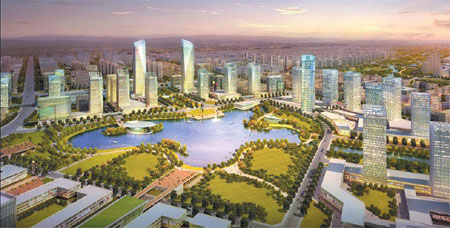Nation's first airport economic zone taking off
|
The planned Zhengzhou Airport Experimental Zone will cover an area of 415 square kilometers that crosses the boundaries of three counties in Zhengzhou. |
As part of the ongoing efforts to integrate ground and air transportation in Zhengzhou, the local government is planning a development zone near the city's airport.
The Zhengzhou Airport Economic Experimental Zone will be a base for industries related to air transportation and logistics. It is expected to develop into a new engine for economic growth in central China by 2025, according to the city government.
The plan for the experimental zone was officially approved by the State Council on March 7, making it the first airport economic zone at the national level.
Zhengzhou has long been a land transportation hub in central China, with well-developed railway and highway networks that provide convenient access to the entire country.
When the central government introduced the Rise of Central China plan in 2006, Zhengzhou was named as the location of a future comprehensive, land-air trans-modal transportation hub.
In 2010, Foxconn - the renowned original equipment manufacturer for Apple and other IT giants - launched a huge production facility in Zhengzhou, immediately generating huge demand for air and air-land trans-modal transportation.
Also in the same year, the Zhengzhou Xinzheng Comprehensive Free Trade Zone was established, paving the way for the construction of the airport zone.
In 2012, cargo throughput in the Zhengzhou airport increased 47 percent compared with the previous year to reach 151,200 tons, the fastest growth among all major domestic airports.
At present, the airport zone covers an area of 415 square kilometers that crosses the boundaries of three counties under the jurisdiction of Zhengzhou. It includes the airport, a free trade zone and neighboring industrial parks.
Construction started on the project this year and will be complete in 2025.
The city government of Zhengzhou has great expectations for this new economic zone because of its significant geographical advantages.
Enterprises in the zone have easy access to markets and resources, either through land or air transportation.
In addition, the Zhengzhou airport has rich land resources for further expansion, making it possible to accommodate more flights in the future, according to the city government.
As a result, enterprises in the surrounding zones and parks can be freed from bottlenecks in transportation, especially when engaged in foreign trade.
The local government also expects the new zone will further help globalize the local economy because air transportation is the most effective way to ship high-tech products, like the iPad and iPhones manufactured by Foxconn for Apple.
With the impending arrival of more high-tech companies, the local government hopes the zone can help local businesses climb up the higher value chain, contributing to industrial restructuring in Zhengzhou and throughout the region.
The project will be developed in two phases.
The infrastructure facilities and public service system will be in place by 2017. An industrial system of advanced manufacturing and modern services will take shape by then.
The entire project will be completed in 2025.
By that time, the annual cargo throughput of the airport is projected to reach 3 million tons, revenues from the zone's advanced manufacturing industries will surpass $1 trillion and foreign trade value will reach $20 billion, according to estimates of the city government.



















